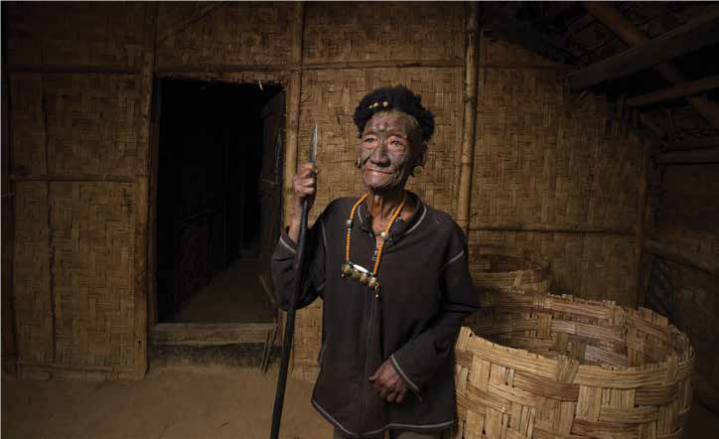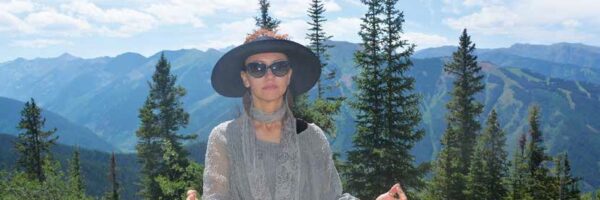
The headhunters of Nagaland
In the north east of India, bordering with Myanmar, is the city of Long Wa which is home to the last living headhunters of Nagaland. These older tattooed men are surrounded by green forests prosperous with nature and who live a traditional way of life.
As a university photography professor, I am always looking for unique ways to challenge my creative works. A
practicing creative teacher means better classes and output for students. I came across an article discussing
what was titled “The Last Living Headhunters of Nagaland” by an Indian photographer living in New York City named Trupal Pandya. The idea that headhunters were alive and their traditional ways of life still active captured my imagination. As I read more I discovered that there were some conflict areas in Nagaland with the Indian government and that the headhunters’ way of life was actually changing through development and government pressures, in some instances. I did not find as much information as I would like to online so I applied for creative research funding from Webster University Thailand and once approved started my planning to photograph Nagaland.
Long Wa is one of the larger villages located in the Mon district. Part of the village is located in India while
the other half is located in Myanmar. The village is controlled by a chief, or as referred to by the villagers, the Angh (King). Half of the Angh’s home is in India and the other half in Myanmar. Upon my arrival I was greeted by
our translator and fixer named Long Shaw. Long Shaw is a warm-hearted villager from Long Wa, who currently
lives in the city of Mon, whose aim is to promote and bring awareness to the unique culture of his village. I was
immediately brought to meet with the Angh of Long Wa. A pleasant man who has just recently taken over the title of Angh as his father had just recently passed away. Once introduced to many people around the village my photographic journey became a reality.
The first thing I discovered about photographing in Long Wa is that everything is a nice long walk and
usually up hill. Luckily I had good set of hiking boots on to help me with the walks to come. I found that people were just as curious about me as I was about them. When discussing my plans with Long Shaw, he had mentioned that approximately only 150 tourists pass by Long Wa a year and about 90% don’t stay longer than a day and a large percentage of those never get out of their cars. Nagas, people of Nagaland, are know for being a strong tribal people and often are given a feared reputation amongst the rest of India. Of these people the Konyak tribe is revered as some of the most traditionally feared for their headhunting. Men were often
encouraged to partake in headhunting activities by women before marriage would be possible. Men who took part in headhunting expeditions would receive a chest tattoo while men who successfully took another warriors
head, from a rival tribe, would receive a face tattoo. Men who had taken more than 6 heads would receive a neck
tattoo.
I found that most people were open to talking to me outside of their homes and once they realised that I was there to document and respect their culture I was invited into their homes. As I started photographing many of these people I felt a warm interaction of sharing culture and acceptance. Many of these tattooed warriors would share tea with me and upon seeing my first images offered to wear a more traditional headhunting outfit. Even though these men where in their mid-80s and their last headhunting expedition was many years ago I noticed a great sense of pride in these outfits.
As I began to earn trust with people in the village, we started to talk about the subject of face tattoos.
These men shared the great honour that comes with the face tattoo. It helped them sell their products at the market, most men were farmers or hunters, it helped them meet their wives and earned them respect from elders, the youth and the Angh. These tattoos could only be given by the Queen and required a big ceremony. The tattoos were in the shape of a skull and to this day are still strong in colour. I couldn’t help thinking how intimidating these men would have been to photograph when they were younger.
As these elders opened up more, they shared their concerns with the amount of fighting in the world and amongst young people. As I sit amongst headhunters I am a bit surprised about their anti fighting views and soon came to realise these are just ordinary elder men that are filled with wisdom only gained from life experience. The outside view of the vicious headhunter clouds the reality that these men were warriors fighting in their traditional ways. Often headhunting raids were no more than 10 men against 10 men.
 As the region develops and outside religions take over these older men are in limbo between the new and old worlds. Their fears of the massive young adult drug addiction are valid and is the cause for much of the farming, craftsmanship and hunter traditions being lost. This being said there is a movement by key people in the village, including key headhunters and my guide Long Shaw, to reeducate the youth of traditional ways of farming, hunting and their heritage. Allowing the youths of the village to have the benefits of both worlds. Although headhunting was made illegal in the 1960s there is a tremendous amount of respect giving towards the last living tattooed men of Long Wa. I did hear stories that the last headhunting raid was in the early 90s but no one would share the full information with me.
As the region develops and outside religions take over these older men are in limbo between the new and old worlds. Their fears of the massive young adult drug addiction are valid and is the cause for much of the farming, craftsmanship and hunter traditions being lost. This being said there is a movement by key people in the village, including key headhunters and my guide Long Shaw, to reeducate the youth of traditional ways of farming, hunting and their heritage. Allowing the youths of the village to have the benefits of both worlds. Although headhunting was made illegal in the 1960s there is a tremendous amount of respect giving towards the last living tattooed men of Long Wa. I did hear stories that the last headhunting raid was in the early 90s but no one would share the full information with me.
I went into the jungles and mountains of North East India in search of the feared tattooed men of the Konyak tribe but soon found respected warriors in fear of a disappearing culture and that their stories would be lost. It would be a mistake for any visitor to think these older men are frail because of age as I can attest these men still carry a great strength and are supported by a very strong female counterpart.
My trip wouldn’t have been possible with out the support of Webster University and the amazing team of wonderers I  travelled with, Yakov, Sam, Priyanka, Jill and the fixer Trupal. And of course our guide and translator Long Shaw. If you are planning on visiting Long Wa please make sure you organise a trip through an official channel as there are still a lot of anti government groups in the region.
travelled with, Yakov, Sam, Priyanka, Jill and the fixer Trupal. And of course our guide and translator Long Shaw. If you are planning on visiting Long Wa please make sure you organise a trip through an official channel as there are still a lot of anti government groups in the region.
Thomas Groves is a Webster University Media Communications lecturer holding his BA, MA in Media Communications and a Post Graduate Certificate in Education. He teaches photography, digital production, advertising and communications theory. He is an avid photographer who enjoys travelling around the world documenting the beautiful and the strange.



